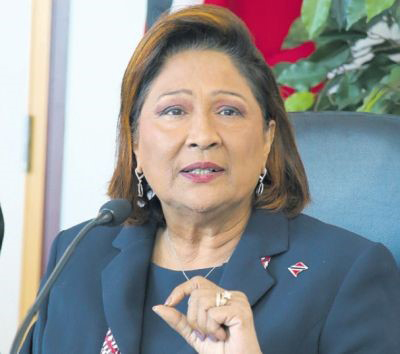A sovereign wealth fund should only be used for rainy day planning and not to be used to supplement recurring expenditure as was done recently in Trinidad and Tobago says T&T’s former prime minister and Leader of the Opposition, Kamla Persad-Bissessar.
“I do not recommend, from what I have seen in Trinidad and Tobago, that any sovereign wealth fund (SWF) that you set up, be used to supplement recurring expenditure.”
Guyana’s proposed sovereign wealth fund is called the Natural Resources Fund.
Addressing the manufacturing sector and invitees at the Guyana Manufacturing and Services Association’s annual presentation award dinner on Thursday evening, she said, “Your SWF has to be seen as an insurance policy. It should not be seen as a cash cow that anytime you have a financing deficit in your budget that you would dip into it and come back out. It does not work like that. It should only work in special circumstances.”
She noted that for the first time since T&T’s sovereign wealth fund – known as the Heritage and Stabilisation Fund (HSF) – was set up, the current administration “has seen it fit, twice, to raid the HSF for the purpose of recurrent expenditure.”
Recurrent expenditure brings no return or no development, and whatever legislation is put in place to protect Guyana’s SWF, she suggested, provisions should be put in place to prohibit drawdowns for recurrent expenditure.
Even though T&T’s HSF has two parts – heritage and stabilisation, she said, the way the legislation is framed the two are not clearly spelt out.
Promises were made to amend the law to allow for the heritage part of it to be separated from the stabilization part, she said, but that is yet to be done.
She suggested that Guyana should look to having two parts to its SWF which should be clearly spelt out.
Raiding the SWF to supplement the annual treasury’s expenditure, she said, would be defeating the purpose of the SWF and it has the potential to significantly destabilise the national economy.
T&T, having had the HSF for a number of years, Persad-Bissessar said, “It is a good idea to have this rainy day fund. The question is the formula. How will it be structured?”
She believes the HSF was great when it began but over the years it has become deficient. “I have seen where we can amend that piece of law to improve it and get us a better formula.”
While SWFs are often linked to oil prices or can be a legal clause in a petroleum licence or petroleum production contract, she said, there are many economic tools which can be used to channel resources into such a fund.
“These funds act as buffers given the volatile pricing and shocks and production issues involved in the hydrocarbon industry,” she said.
Other supplemental tools such as petroleum production taxes (PPTs), supplemental petroleum taxes (SPTs), a petroleum impost and clauses for increased scales of taxation for supernormal finds, she said, may be worthy of consideration.
While T&T has many laws relating to the hydrocarbon sector, she said, many have been amended over the years and many now need amending.
While the SWF is set up in many cases for oil and gas and other natural resources which are finite, Persad-Bissessar said, Guyana must be prepared for two shocks – output and price shocks.
Apart from full production to wells drying up, she said, the price of oil could go from US$100 barrels a day today to a low figure tomorrow.
“It is a totally uncertain set of circumstances over which we have no control. Price shocks can lick you out of the water. When those things happen and you are dependent on the oil and gas sector and those prices drop down, as has happened in Trinidad and Tobago within the last two years or so, then you are in real trouble in the entire economy. Your SWF is your rainy day planning for output and price shocks.
It was important to keep in mind, she said, that hydrocarbons are naturally declining resources.
“This is the challenge we faced in 2010, where oil production was falling and faced with that crisis, we undertook unprecedented activities to reverse this trend of declining production.”
The government amended several pieces of legislation to incentivise the hydrocarbon sector through a fiscal package which, she said, included capital allowances and deferral of tax credits to attract foreign direct investments.
“We set about a series of bid round packages based on the seismic data in blocks being offered. We sold this around the world,” she said.
The activities of the Ministry of Energy, she noted, are funded by the petroleum companies under the Petroleum Impost Act so this was at no cost to the treasury.
The sales of the data packages brought in profits in the process, she said.
Her government, she said, also engaged in transparent and frank discussions with investors, suppliers and stakeholders in the petroleum sector.
These strategies and others saw T&T only now starting to return to higher levels of natural gas production, she said. “We have investments from the BP Juniper Project which started in the second half of 2017. This project brought 590 million cubic feet of natural gas per day into production.”
BP’s decision to invest over US$2.1 billion in this project, she said, happened in August 2014 due in part to fiscal incentives her government at the time offered.
Other investment projects including, Angelin, TROC and BHP Greater Angostura came to fruition, she said, during her term in office because of the incentives then put into place.
“Our production levels were way down. We had to act and act fast, which we did from 2010 and onwards.”
She added, “When all these projects are right up to speed, we will have millions of cubic feet of natural gas coming in.”






